This article was medically reviewed by Sarah Gehrke, RN, MS. Sarah Gehrke is a Registered Nurse and Licensed Massage Therapist in Texas. Sarah has over 10 years of experience teaching and practicing phlebotomy and intravenous (IV) therapy using physical, psychological, and emotional support. She received her Massage Therapist License from the Amarillo Massage Therapy Institute in 2008 and a M.S. in Nursing from the University of Phoenix in 2013.
There are 12 references cited in this article, which can be found at the bottom of the page.
wikiHow marks an article as reader-approved once it receives enough positive feedback. In this case, 93% of readers who voted found the article helpful, earning it our reader-approved status.
This article has been viewed 1,417,245 times.
A big, ugly scab can ruin a big night out, make it hard to wear skirts or shorts, and just seem unsightly. The most reliable way to get rid of a scab is to properly dress the wound so it heals quickly. You can also try some gentle treatment techniques to ease discomfort and possibly minimize scabbing. Above all, don’t pick at the scab![1]
Steps
Dressing the Scab
-
1Make sure the scab is not oozing. Before you can properly dress a wound or scab, it should be dry. If your wound is oozing blood, place some sterile non-adhering gauze on it. If it soaks through the gauze, don’t remove it. Removing it can restart bleeding by pulling off the healing tissue. Just place another layer of gauze on top.[2]
- Keep the gauze in place until the wound stops oozing.
-
2Clean all around the scab. Even if your wound has already started to scab over, it’s important to keep it clean and moist. This helps it heal faster. Simply rinse the wound with warm water. Lightly pat it dry.[3]Advertisement
-
3Moisten the scab to help it heal faster. While old ways assumed that keeping a scab dry helped it heal faster, modern research says keeping it moist is best. Slather a layer of petroleum jelly all over and around the scab after you have cleaned it.[4]
- You can also use antibacterial ointment instead of petroleum jelly, but this isn’t necessary for most wounds.
-
4
-
5Put a fresh bandage on every day. While you’re waiting for the scab to heal, take time to remove the bandage each day and clean the site. Moisten the scab again and cover it with a new bandage.[7]
- The scab still won’t disappear instantly, but this will definitely speed up the healing process.
Treating the Scab
-
1Massage your scab to get some relief. Picking at your scab is a no-no, since this can cause scarring and make it take even longer for the wound to heal.[8] If you want some relief from the itching that will also help get rid of the scab, try gently massaging it with a bit of petroleum jelly or moisturizing lotion. You can do this each time you put a new bandage on.[9]
-
2Try a soothing warm compress. For some instant relief, soak a clean cloth in plain warm water. Let it sit on the scab for fifteen minutes, but don’t rub or scrub. This will provide relief from the irritation that makes you want to pick the scab. The water will also moisturize the scab, helping it to heal faster.[10]
-
3Coat the skin in a homemade paste once the scab comes loose. Mix some baking soda with enough water to make a paste. Apply the paste over the entire scab and let dry. When you’re done, rinse it away with warm water. This will tighten the scab and draw it gently from the skin.[11]
- You can do the same thing with potassium alum, a naturally occurring form of aluminum salt, and is widely used as a deodorant and styptic (or astringent). Look for it at your local pharmacy.
- Alum tightens the scab by constricting the surrounding blood vessels, ultimately loosening the scab from its mooring on the skin.
-
4Dab at the scab with natural remedies. Several common products can kill germs, helping the wound to heal and the scab to clear up. Just soak a cotton ball or swab in the product, then dab it on your scab. Let it sit for a few minutes, then rinse and apply a new dressing. Try:
Expert Q&A
Did you know you can get expert answers for this article?
Unlock expert answers by supporting wikiHow
-
QuestionWhat can I use to cover a scab on my face?
 Ashleigh GroundsAshleigh Grounds is a Makeup Artist and Hair Stylist based in Austin, Texas. Ashleigh has over 11 years of cosmetology experience. She studied cosmetology in Dallas, Texas and completed a two-year hair salon apprenticeship in Kuala Lumpur, Malaysia with Toni & Guy Hair Salon. She is accredited by the International Board of Cosmetology, is a certified Babe Hair Extension Professional, and is a certified Brazilian Blow Out Professional. Ashleigh was voted the best Hair Stylist in Austin for 2012 by RAW Artists and was voted in the top 20 salons for 2020 in Austin by Expertise. Ashleigh's work has been featured in Talentmagazines, BlogTalkRadio, KXAN, and Studio 512.
Ashleigh GroundsAshleigh Grounds is a Makeup Artist and Hair Stylist based in Austin, Texas. Ashleigh has over 11 years of cosmetology experience. She studied cosmetology in Dallas, Texas and completed a two-year hair salon apprenticeship in Kuala Lumpur, Malaysia with Toni & Guy Hair Salon. She is accredited by the International Board of Cosmetology, is a certified Babe Hair Extension Professional, and is a certified Brazilian Blow Out Professional. Ashleigh was voted the best Hair Stylist in Austin for 2012 by RAW Artists and was voted in the top 20 salons for 2020 in Austin by Expertise. Ashleigh's work has been featured in Talentmagazines, BlogTalkRadio, KXAN, and Studio 512.
Makeup Artist & Hair Stylist
-
QuestionWill this work for scabs on my face?
 Sarah Gehrke, RN, MSSarah Gehrke is a Registered Nurse and Licensed Massage Therapist in Texas. Sarah has over 10 years of experience teaching and practicing phlebotomy and intravenous (IV) therapy using physical, psychological, and emotional support. She received her Massage Therapist License from the Amarillo Massage Therapy Institute in 2008 and a M.S. in Nursing from the University of Phoenix in 2013.
Sarah Gehrke, RN, MSSarah Gehrke is a Registered Nurse and Licensed Massage Therapist in Texas. Sarah has over 10 years of experience teaching and practicing phlebotomy and intravenous (IV) therapy using physical, psychological, and emotional support. She received her Massage Therapist License from the Amarillo Massage Therapy Institute in 2008 and a M.S. in Nursing from the University of Phoenix in 2013.
Registered Nurse
-
QuestionWill this work on scabs that have turned black?
 Sarah Gehrke, RN, MSSarah Gehrke is a Registered Nurse and Licensed Massage Therapist in Texas. Sarah has over 10 years of experience teaching and practicing phlebotomy and intravenous (IV) therapy using physical, psychological, and emotional support. She received her Massage Therapist License from the Amarillo Massage Therapy Institute in 2008 and a M.S. in Nursing from the University of Phoenix in 2013.
Sarah Gehrke, RN, MSSarah Gehrke is a Registered Nurse and Licensed Massage Therapist in Texas. Sarah has over 10 years of experience teaching and practicing phlebotomy and intravenous (IV) therapy using physical, psychological, and emotional support. She received her Massage Therapist License from the Amarillo Massage Therapy Institute in 2008 and a M.S. in Nursing from the University of Phoenix in 2013.
Registered Nurse Yes, these steps can work. The dark rusty-brown color, often black, is the scab--the crust the forms over the injured area (the coagulation of blood). The best thing you can do is keep your scab moist no matter how dark of a color it has turned. The scab will generally remain in place until the skin underneath has been repaired and new skin cells have appeared, after which it naturally falls off!
Yes, these steps can work. The dark rusty-brown color, often black, is the scab--the crust the forms over the injured area (the coagulation of blood). The best thing you can do is keep your scab moist no matter how dark of a color it has turned. The scab will generally remain in place until the skin underneath has been repaired and new skin cells have appeared, after which it naturally falls off!
References
- ↑ https://www.ncbi.nlm.nih.gov/pmc/articles/PMC479044/
- ↑ http://www.sja.org.uk/sja/first-aid-advice/first-aid-techniques/how-to-put-on-a-dressing.aspx
- ↑ https://www.nursingtimes.net/clinical-archive/tissue-viability/when-is-wound-cleansing-necessary-and-what-solution-should-be-used-20-08-2018/
- ↑ https://journals.lww.com/prsgo/fulltext/2019/10000/simple_effective_ways_to_care_for_skin_wounds_and.24.aspx
- ↑ https://www.ncbi.nlm.nih.gov/pmc/articles/PMC6225154/
- ↑ https://www.ncbi.nlm.nih.gov/pmc/articles/PMC4662938/
- ↑ https://www.aad.org/public/skin-hair-nails/injured-skin/wound-care
- ↑ https://www.ncbi.nlm.nih.gov/pmc/articles/PMC479044/
- ↑ http://kidshealth.org/en/teens/wounds.html#
About This Article
To get rid of a scab, keep it moist by covering it with a layer of petroleum jelly and a bandage every day so it heals faster. Once the scab starts to come loose, make a paste with baking soda and water and apply it to the scab to help tighten it and draw it away from your skin. When the paste is dry, rinse it off with warm water and your scab should come right off! To learn more from our Registered Nurse co-author, like how to clean the scab when you first get it, keep reading the article!
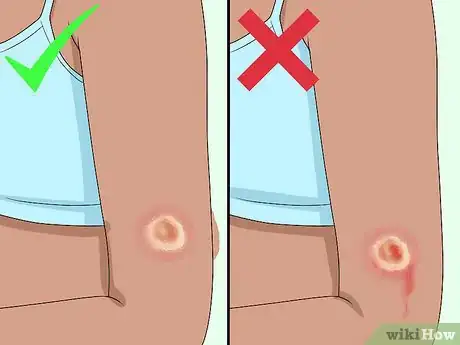
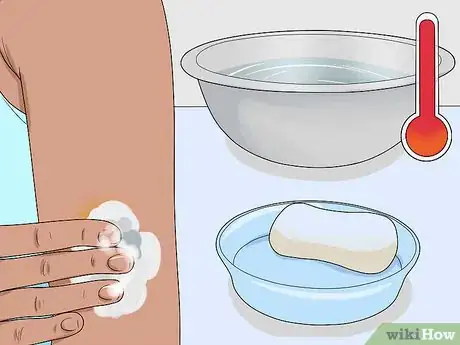

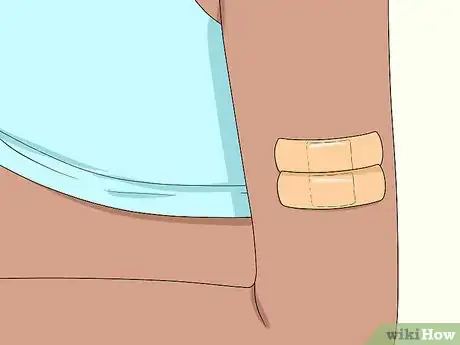
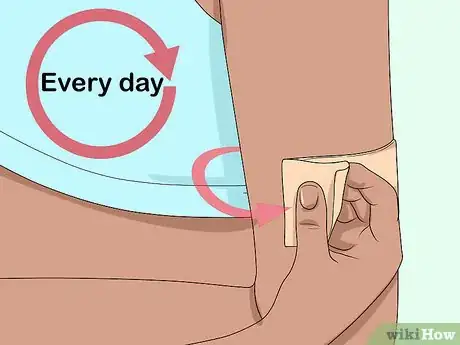
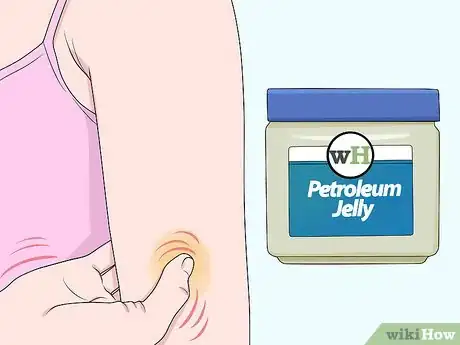

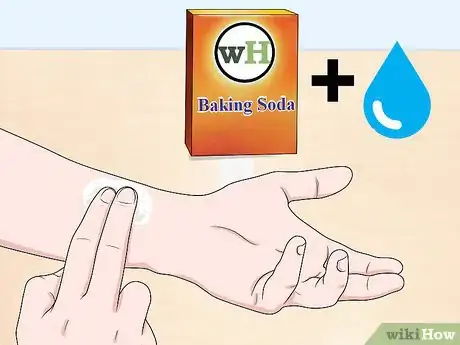


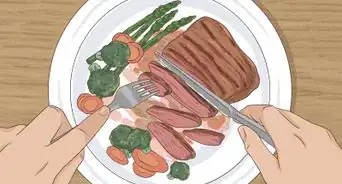
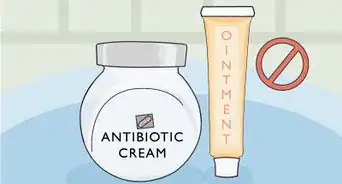






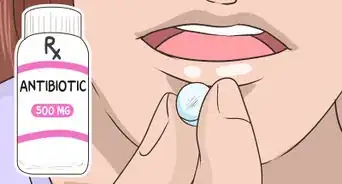
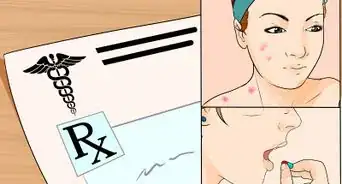


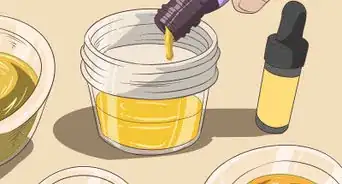












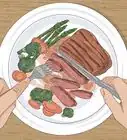





































Medical Disclaimer
The content of this article is not intended to be a substitute for professional medical advice, examination, diagnosis, or treatment. You should always contact your doctor or other qualified healthcare professional before starting, changing, or stopping any kind of health treatment.
Read More...